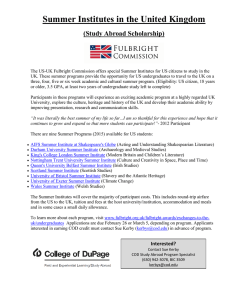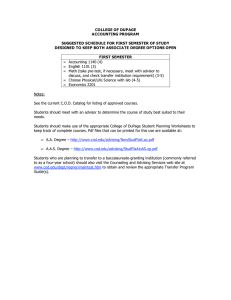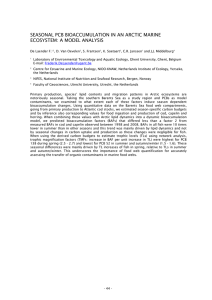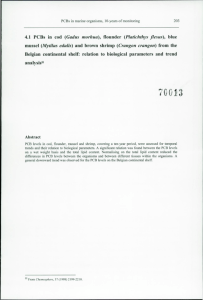ECOTOX1
advertisement
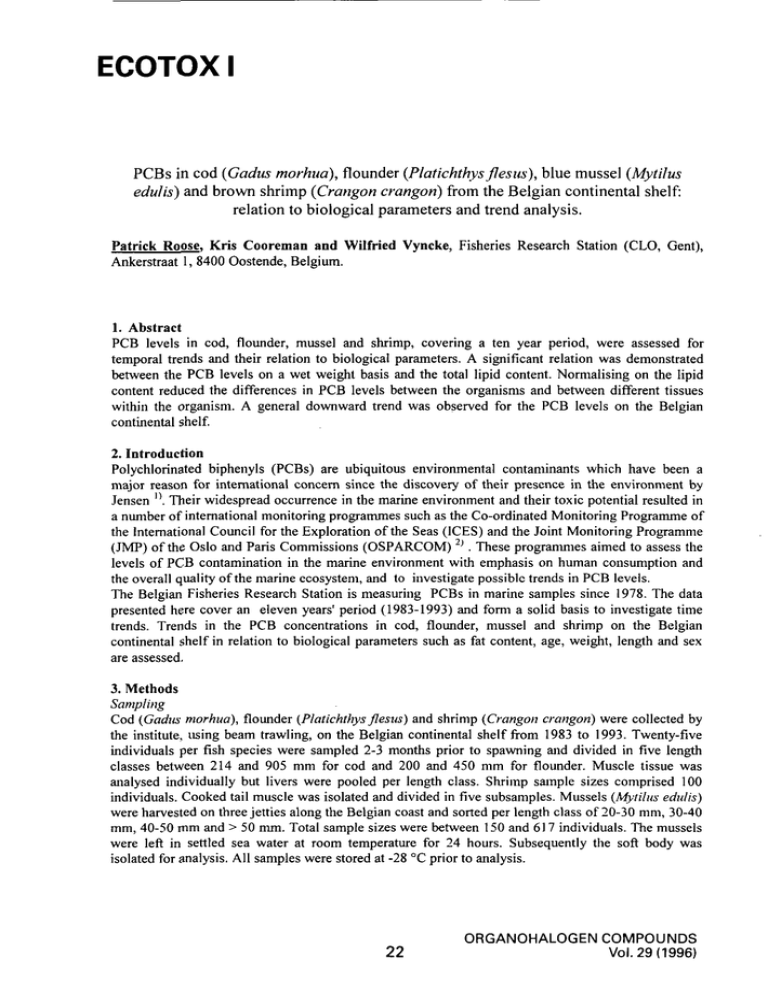
ECOTOX1
PCBs in cod (Cadiis morhua), flounder {Platichthys flesus), blue mussel (Mytilus
edulis) and brown shrimp (Crangon crangon) from the Belgian continental shelf:
relation to biological parameters and trend analysis.
Patrick Roose. Kris Cooreman and Wilfried Vyncke, Fisheries Research Station (CLO, Gent),
Ankerstraat 1, 8400 Oostende, Belgium.
1. Abstract
PCB levels in cod, flounder, mussel and shrimp, covering a ten year period, were assessed for
temf)oral trends and their relation to biological parameters. A significant relation was demonstrated
between the PCB levels on a wet weight basis and the total lipid content. Normalising on the lipid
content reduced the differences in PCB levels between the organisms and between different tissues
within the organism. A general downward trend was observed for the PCB levels on the Belgian
continental shelf
2. Introduction
Polychlorinated biphenyls (PCBs) are ubiquitous environmental contaminants which have been a
major reason for intemational concern since the discovery of their presence in the environment by
Jensen ". Their widespread occurrence in the marine environment and their toxic potential resulted in
a nimiber of intemational monitoring programmes such as the Co-ordinated Monitoring Programme of
the Intemational Council for the Exploration ofthe Seas (ICES) and the Joint Monitoring Programme
(JMP) ofthe Oslo and Paris Commissions (OSPARCOM)"'. These programmes aimed to assess the
levels of PCB contamination in the marine environment with emphasis on human consumption and
the overall quality ofthe marine ecosystem, and to investigate possible trends in PCB levels.
The Belgian Fisheries Research Station is measuring PCBs in marine samples since 1978. The data
presented here cover an eleven years' period (1983-1993) and fomi a solid basis to investigate time
trends. Trends in the PCB concentrations in cod, floimder, mussel and shrimp on the Belgian
continental shelf in relation to biological parameters such as fat content, age, weight, length and sex
are assessed,
3. Methods
Sampling
Cod (Gadus morhua), flounder (Platichthys flesus) and shrimp (Crangon crangon) were collected by
the institute, using beam trawling, on the Belgian continental shelf from 1983 to 1993. Twenty-five
individuals per fish species were sampled 2-3 months prior to spawning and divided in five length
classes between 214 and 905 mm for cod and 200 and 450 mm for flounder. Muscle tissue was
analysed individually but livers were pooled per length class. Shrimp sample sizes comprised 100
individuals. Cooked tail muscle was isolated and divided in five subsamples. Mussels (Mytilus edulis)
were harvested on three jetties along the Belgian coast and sorted per length class of 20-30 mm, 30-40
mm, 40-50 mm and > 50 mm. Total sample sizes were between 150 and 617 individuals. The mussels
were left in settled sea water at room temperature for 24 hours. Subsequently the soft body was
isolated for analysis. All samples were stored at -28 °C prior to analysis.
22
ORGANOHALOGEN COMPOUNDS
Vol. 29 (1996)
ECOTOX1
Chemical analysis
Extraction was based on total lipid extraction according to the method of Bligh and Dyer '' . The
extracted lipids firstly used for the determination ofthe fat content were redissolved in hexane, and the
resuhing solution was subsequently cleaned on a florisil'"'''. Analysis was perfonned using capillary
gas chromatography with electron capture detection. Prior to 1989, the PCB concentrations were
calculated on the basis of comparison with 8 PCB peaks of Aroclor'''. These eight peaks corresponded
with IUPAC nrs. 101, 136, 147, 153, 138, 128, 180 and 170 ^. Concentrations of individual
congeners, viz. IUPAC n° 28, 31, 52, 101, 105, 118, 138, 153, 156 and 180 ''\ are determined since
1989 ^'. Prior to 1990 quality assurance consisted ofthe analysis of procedural blanks, reproducibility
and repeatability tests, injection of standard solutions as unknowns and analysis of samples with
known concentrations. Since 1990 the analysis of a certified reference material (BCR CRM 349) was
added to the above list as a standard procedure.
Cod
Flounder
Ol
•a.
u
0.25
1 25
0.50
Mussel
i
-1.25-
^r.
c.?
s%
-1.50-
Shrimp
•
-
5'
o
. '*\.-^r::::::^^^^^^^^
^''^A.^'f"!^^^'""
• ..
1..--"
•
-1.75-
*
3
%
D>
a^
3.£
••
-2.0-
•
iiys:^
C.S
-2.5-
ml
o
.
^ -r:^^^^ •.»
-3 0-
1
.-•••
r= 0.514
°
r= 0.497
-2.00^
-?l 52
1
2
% Fat
% Fat
Figure 1 Relationship between the fat content and log(PCB) expressed on a wet weight basis (r = correlation coefficient,
dolled line = 95% confidence interval)
Statistical analysis
All statistical analyses were performed on total PCB concentration and the significancy level was set
at minimum 95%. Correlations between fat content, length of the animal and PCBs were analysed by
linear regression. The non-parametric Mann-Withney test was used to investigate the relation between
sex and PCB concentrations; and the non-parametric Kruskall-Wallis ANOVA test combined with
Dunns' post test was performed to compare the PCB contents of liver and muscle tissues in and
among species and to investigate the influence of the age of the animals on the PCB content. Time-
ORGANOHALOGEN COMPOUNDS
Vol. 29 (1996)
23
ECOTOX1
trend analysis of the PCB concentrations (median values per year) in cod, flounder and mussel were
investigated according to the method of Nicholson et al. . PCB trends in shrimp were analysed by
linear regression.
4. Results
Relation betiveen the PCB concentration and the fat content.
Fig. 1 illustrates the relation between fat content and log(ZPCB), both on wet weight basis for cod,
flounder, blue mussel and brown shrimp. A significant correlation is present between the log(ZPCB)
expressed on a wet weight basis and the fat content. In contrast, no correlation could be demonstrated
between log(ZPCB) expressed on a fat weight basis and the fat content. Fig 2 illustrates the effect of
lipid normalisation ofthe PCB data for all species and tissues examined. The results of Kruskal-Wallis
ANOVA analysis ofthe data indicate significant (P<0.001) inter-tissue and inter-species differences.
However, narrowing this down with Dunn's post test revealed that the differences between cod liver,
flounder liver, flounder muscle and blue mussel (soft body tissue) became non-significant. It can
therefore be concluded that normalisation on the lipid content clearly reduced the differences between
organisms and tissues.
^ ^ C o d : mjscle
E ^ C o d : li\«r
^ ^ Flounder: muscle
• • Flounder: &\«r
1 = 1 Mussel: soft body
OHD Shrimp: tail iriiscle
^ ^ C o d : muscle
^ ^ C o d : iwr
^ ^ Rounder: muscle
• • R o u n d e r : Ever
[ ^ Mussel: soft body
cm] Shrimp: tail rruscle
species and tissue
Spoclos and tissues
Figure 2 PCB concentration on (A) wet weight and (B) fat weight for cod flounder, mussel and shrimp.
Relations between the I ^ C B concentrations and size, sex and age.
The trend analysis of Nicholson et al. ' dictates a different approach when a size effect is established.
Fig. 3 illustrates the relations between length and the PCB concentration. No demonstrable size effects
on the ZPCB concentrations in the tissues and species could be shovm except in cod liver, especially
in those animals ranging in size over 60 cm. In addition to body size, the ZPCB concentrations were,
when possible, also related to sex and age, but no significant relations could be demonstrated. These
results confirm the assumption that the contaminant trend is not influenced by the animals' age- and
sex-status.
Temporal-trend analysis.
The observed absence of relations between the PCB content and the animals' length, age or sex
allowed the analysis of temporal trends in cod muscle, flounder muscle and flounder liver tissues and
in blue mussel without statistical modifications, except in cod liver in which a length effect was
demonstrated and in brown shrimp for which the length effect was not examined. The analysis of the
cod liver data required a different approach. These data were subdivided into a "small" and a "large"
group, both analysed independently '. Temporal trends in brown shrimp data were analysed by linear
regression. The temporal trends are illustrated in Fig. 3. Long-term changes in the PCB concentrations
were only considered as significant within a 95% confidence interval . The results revealed (I)
significant differences in cod and flounder muscle tissues and flounder liver tissue, (2) a significant
downward non-linear trend in cod muscle (Fig. 3.), (3) a significant downward linear trend in flounder
24
ORGANOHALOGEN COMPOUNDS
Vol. 29 (1996)
ECOTOX1
muscle (Fig. 3) (4) no trend in blue mussel tissue, (5) a significant downward trend in brown shrimp
(Fig. 3) and (6) no significant trends in cod and flounder liver tissues.
Cod: muscle
Cod: liver
r2=-0.14
Ol
m
u
m
o
V
h^
"^
-L
fM4"
83 84 85 66 87 88 89 90 91 92 93
83 84 85 86 87 88 89 90 91 92 93
Year
Year
Flounder: muscle
Flounder: liver
r= -0.27
7.5
ro
O)
10.
O)
•a
O
m
o
5-
"F
T
1
•f
* T"
83 84 85 86 87 88 89 90 91 92 93
83 84 85 86 87 88 89 90 91 92 93
Year
Year
Mussel: soft body
Shrimp
O)
Th
O)
nn-
a.
c
-0.5m
o
•a
m
u
_i
-10-
T
^
•-
-.,
^T~~T1
r= - 0.725
^^-^ —~3I1
T'-C:
-1 582 83 84 85 86 87 88 89 90 91 92 93 94
83 84 85 86 87 88 89 90 91 92 93
Year
Year
Figure 3 PCB concentrations in ug/g fat weight for cod, flounder and mussel (lines illustrate calculated significant trends,
r = correlation coefficient) and linear trend for the log(CB) concenU'ation in shrimp.
5. Conclusions
PCB concentrations expressed on a wet weight basis show a significant correlation with the fat
content. Tliis finding agrees well with previous observations *'""'. Moreover, interspecies and tissuetype differences decreased when PCB concentrations were normalised for the fat content. The
ORGANOHALOGEN COMPOUNDS
Vol. 29 (1996)
25
ECOTOX1
correlation between fat content and log(ZPCB) illustrates the need for a normalisation of the PCB
concentrations on lipid (fat) content, especially when a time trend assessment is envisaged. Natural
variations in the lipid content of an organism or organ, due to spawning or starvation, may influence
the variability of contaminant data when these data are expressed on a fresh (wet) weight basis.
Length, age and sex had no measurable effects on the PCB concentrations expressed on a lipid weight
basis, with one exception : PCB concentrations in the liver of cod significantly increased with length
(age). This finding therefore suggests that a significant biomagnification should only be expected for
cod liver. An influence ofthe length of cod on the PCB content in the liver was previously reported by
de Boer '•', who demonstrated a significant concentration difference between individuals of different
sizes (53-54 cm and 85-91 cm). Similarly, Kruse and Kriiger '^' measured higher DDT levels in liver
of Baltic cod with increasing animal size but did not notice similar trends for hexachlorobenzene
(HCB), a-hexachlorocyclohexane (a-HCH) and dieldrin. The presence of contaminants such as PCBs
in poikilotherms is the result of a combination of uptake (directly from the water, ingestion of
contaminated particles and food) and elimination (metabolisation, excretion, growth dilution). An
explanation for the age-dependent biomagnification level in cod liver may be found in the regime of
cod. Older cod mainly feed on fish, which is more contaminated than invertebrates that are preferably
consumed by younger individuals '''•'. A major route of PCB uptake in older cod is therefore food and
leads eventually to biomagnification. Nevertheless, the biomagnification in muscle tissue is not agedependent and might be related to different biological fiinctions since cod mainly uses its liver as lipid
deposition site. The uptake and elimination of PCBs appears to be more balanced in the other species
and tissue-types sampled. In those cases no significant biomagnification could be demonstrated.
Significant do'wnward trends were observed in muscle tissue of cod and flounder, and in shrimp, but
not in mussel and the liver of both fish species. Flounder, blue mussel and brown shrimp are in that
respect excellent indicator organisms that clearly reflect the quality status of their habitats because of
no or restricted migrational activities. Cod has a more enhanced migrational pattem and does not
necessarily reflect the condition ofthe area of capture. Nevertheless, cod is considered to be a suitable
biomonitors for spatial and temporal trend monitoring '^'. The observed temporal trends in this study
are on the same tenor as those recently reported. Decreasing PCB contents of several species and
locations were cited in the 1993 North Sea Quality Status Report ' and recent observations revealed
lower chlorinated PCBs in yellow eel (Anguilla anguilla) from inland waters in The Netherlands '^'.
PCB concentrations in cod (Gadus morhua) from the North Sea decreased significantly, while higher
chlorinated congeners essentially remained at a constant level '*', The constancy ofthe PCB content of
Mytilus edulis was also'noticed by Stronkhorst ' and by Sole et al. ' in Mytilus galloprovincialis
from the western Mediterranean Sea. The general downward trend could indicate that maximum PCB
concentrations have been reached and that the compulsory remedial actions implemented by national
and intemational organisations to improve the quality ofthe marine environment have become fruitful.
However, although PCB concentrations have shown to decrease locally, a global decline should not be
expected during the next years " \ due to the ongoing inputs to the environment by a number of
sources such as leakages ftom landfills and emissions from incinerators. Moreover, the quantities of
PCBs still in use, still exceed the amount that has escaped into the environment'".
6. Acknowledgements
The authors wish to thank Dr. J. de Boer, RIVO, DLO, Ijmuiden, the Netherlands, for his support and
advice in the preparation of this article.
7. References
"Jensen,
(1966): Report of a new chemical hazard. New Scientist 15, 612
Jensen, S.
S, (1966
North Sea Task Force. (1993): North Sea Qualitj' Status Report 1993. Oslo and Paris Commissions, London. 132 pp.
26
ORGANOHALOGEN COMPOUNDS
Vol. 29 (1996)
ECOTOX1
" Bligh, E.G. and Dyer, W.J. (1959): A rapid method of total lipid extraction and purification for organic compounds. Can.
J. Biochem. Physiol. 37, 911-917.
^' Vandamme, K. and Baeteman, M. (1982): Tcneur des organismes niarins des eaux cotieres beiges en PCB et en
pesticides organochlores. Revue de I'Agriculture 2, 1951-1958.
" Roose, P., Cooreman, K. and Vyncke, W. (1993): Correlation between EROD and GSH-T activities and the presence of
organochlorines in tlic liver of dab from the Belgian continental shelf Intemational Council for the Exploration ofthe Seas
(ICES), Kopenhagen, Denmark, E:15, 14 pp.
"' Ballschmiter, K., Bacher, R., Mennel, A., Fisher, R., Riehle, U. and Swerev, M. (1992): The determination of chlorinated
biphenyls, chlorinated dibenzodioxins and chlorinated dibenzofurans by GC-MS. J. High Resolut. Chromatogr. 15.
260-270.
" Nicholson, M.D., Fryer, R.J. and Larsen, J.R, (1993): Revised Statistical Analysis of JMG Conaminant Trend
Monitoring Data. Intemational Council for the Exploration ofthe Seas (ICES), Kopenhagen, Denmark,, MON 11/3/1-8:3,
20 pp.
" Schaefer, R.G., Emst, W., Goerke, H. and Eder, G. (1976): Residues of chlorinated hydrocarbons in North Sea animals
in relation to biological parameters. Ber. Dt. Wiss. Komm. Meeresforsch. 24, 225-233.
" Goerke, H. Eder, G., Weber, K. and Emst, W. (1979): Pattems of Organochlorine residues in animals of different trophic
levels from the Weser Estuary. Mar. Poll. Bull. 10, 127-133.
"" Schneider, R. (1982): Polychlorinated biphenyls in cod tissues from the Westem Baltic. Significance of equilibrium
partitioning and lipid composition in the bioaccumulation of lipophilic pollutants in gill-breathing animals. Meeresforsch.
29, 69-79.
'" Dclbeke, K., Teklemariam. T., de la Cruz, E. and Sorgeloos, P. (1994): Reducing variability in pollution data: thc use of
lipid classes for normalisation of pollution data in marine biota. Int. J. Environ. Anal. Chem. (in press)
'"' De Boer, J. (1994): Spatial differences and temporal trends of bioaccumulating halogenated hydrocarbons in livers of
Atlantic cod (Gadus morhua) from the North Sea, 1977-1992. In Quality Status Report-Scientific Symposium, Ebeltoft Ed.
by North Sea Task Force, London, UK, (in press).
"* Kmsc and KrOger (1981): Organochlor-Pestizide in Dorshlcber. Allg. Fischwirtschal'sz. 33. 168-169.
'•" Daan, N. (1974): Growth of North Sea cod. Neth. J. Sea Res. 6, 479-517.
'*' De Boer, J. and Brinkman, U.A. Th. (1994): Thc use offish as biomonitors for the detcmiination of contamination ofthe
aquatic environment by persistent organochlorine compounds, trends in Anal. Chem. 13, 397-404.
"' De Boer, J. (1995): Analysis and Biomonitoring of Complex Mi.xtures of Persistent Halogenated Micro-contaminants.
Ph.D. Thesis. Free University of Amsterdam, Amsterdam. 323 pp.
'" Stronkhorst, J. (1992): Trends in pollutants in blue mussel Mytilus edulis and Flounder Platichtys flesus from two Dutch
esmaries, 1985-1990. Mar. Poll. Bull. 24, 250-258.
'*' Sole. M., Porte, C, Pastor, D. and Albaiges, J. (1994): Long-term trend of polychlorinated biphenyls and
organochlorinated pesticides in mussels from the westem Mediterranean coast. Chemosphere 21, 1063-1085.
"'Tanabe, S. (1988): P.B.C. Problems in thc ftimre : Foresight from current knowledge. Environ. Poll. 50, 5-28.
ORGANOHALOGEN COMPOUNDS
Vol. 29 (1996)
27
